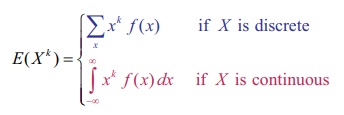Mean, Variance | Probability Distributions | Mathematics - Mathematical Expectation | 12th Maths : UNIT 11 : Probability Distributions
Chapter: 12th Maths : UNIT 11 : Probability Distributions
Mathematical Expectation
Mathematical
Expectation
One of the important characteristics of a random variable is
its expectation. Synonyms for expectation are expected value, mean, and first moment.
The definition of mathematical expectation is driven by
conventional idea of numerical average.
The numerical average of n
numbers, say a1 , a2 , a3 , , an
is

The average is used to summarize or characterize the entire
collection of n numbers a1 , a2 ,
a3 , . . . , an , with single value.
Illustration 11.7
Consider ten numbers 6, 2, 5, 5, 2, 6, 2, −
4, 1, 5 .
The average is [6 + 2 + 5 + 5 + 2 + 6 + 2 −
4 + 1 + 5]/10 = 3
If ten numbers 6, 2, 5, 5, 2, 6, 2, −
4, 1, 5 are considered as the values of a random variable X the probability mass function is given by

The above calculation for average can also be rewritten as

This illustration suggests that the mean or expected value
of any random variable may be obtained by the sum of the product of each value
of the random variable by its corresponding probability.
So average = ∑ (value of x
) ×
(probability)
This is true if the random variable is discrete. In the case
of continuous random variable, the mathematical expectation is essentially the
same with summations being replaced by integrals.
Two quantities are often used to summarize a probability
distribution of a random variable X .
In terms of statistics one is central tendency and the other is dispersion or
variability of the probability distribution. The mean is a measure of the
centre tendency of the probability distribution, and the variance is a measure
of the dispersion, or variability in the distribution. But these two measures
do not uniquely identify a probability distribution. That is, two different
distributions can have the same mean and variance. Still, these measures are
simple, and useful in the study of the probability distribution of X .
Mean
Definition 11.8 : (Mean)
Suppose X is a random
variable with probability mass (or) density function f(x) .
The expected
value or mean or mathematical expectation of X ,
denoted by E( X ) or μ is

The expected value is in general not a typical value that
the random variable can take on. It is often helpful to interpret the expected
value of a random variable as the long-run average value of the variable over
many independent repetitions of an experiment.
Theorem 11.3 (Without proof)
Suppose X is a random
variable with probability mass (or) density function f (x)
. The expected value of
the function g(X) , a new random variable is

If g( X ) = xk
the above theorem yield the expected value called the k-th moment about the origin of the random variable X.
Therefore the k-th moment about the origin of the random
variable X is

Note
When k =
0 , by definition,

Variance
Variance is a statistical measure that tells us how measured data vary from the average value of the set of data. Mathematically, variance is the mean of the squares of the deviations from the arithmetic mean of a data set. The terms variability, spread, and dispersion are synonyms, and refer to how spread out a distribution is.
Definition 11.9: (Variance)
The variance of a random variable X denoted by Var( X ) or V ( X ) or σ 2 (or σx2 ) is
V (X ) = E(X
− E(X ))2 = E(X
− μ)2
Square root of variance is called standard
deviation. That is standard deviation √V( X ) . The variance and
standard deviation of a random variable are always non negative.
Related Topics